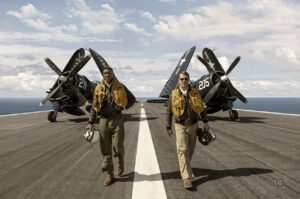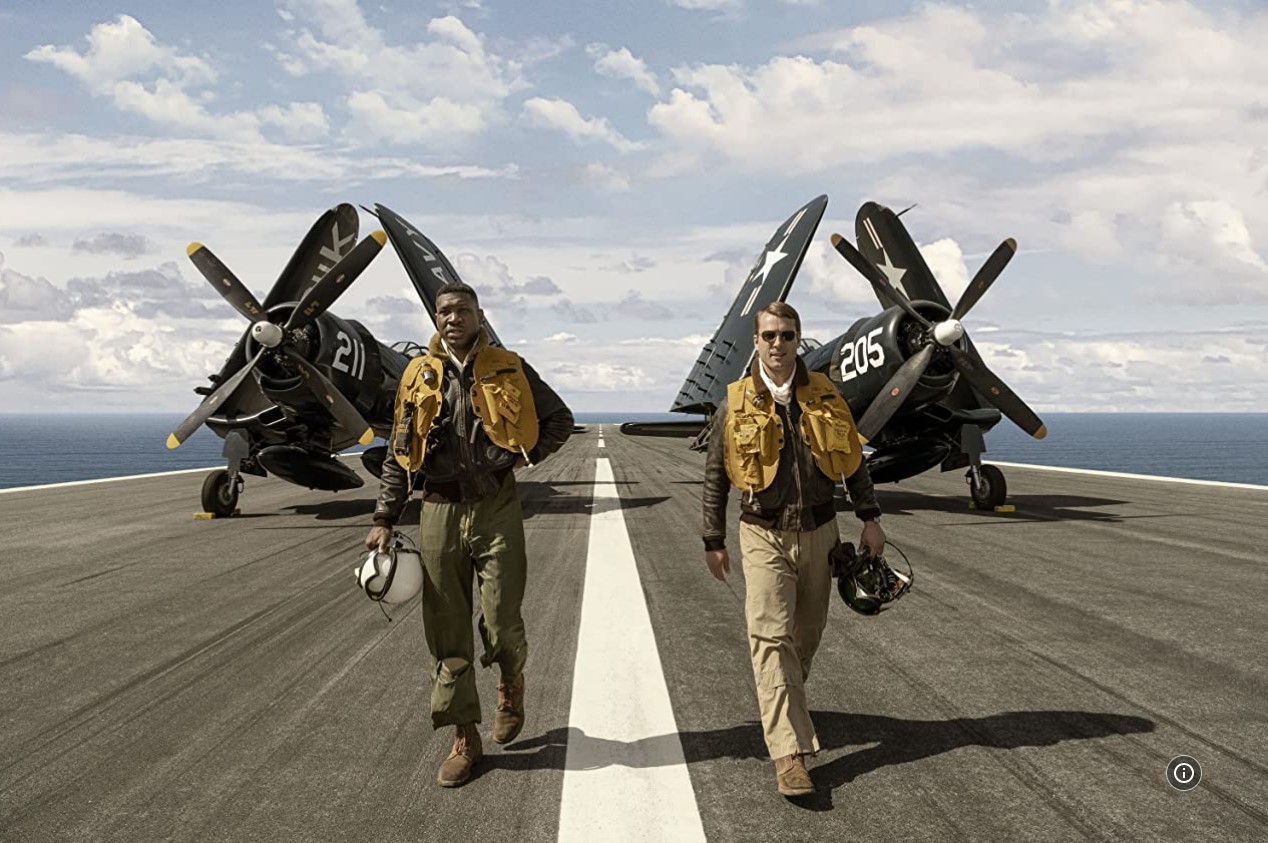Movie Info
Movie Info
- Director
- J.D. Dillard
- Run Time
- 2 hours and 10 minutes
- Rating
- PG-13
VP Content Ratings
- Violence
- 3/10
- Language
- 5/10
- Sex & Nudity
- 1/10
- Star Rating

Director J.D. Dillard along with screenwriters Jake Crane and Jonathan Stewart have given us a fact-based film that commemorates a friendship that transcended the racial barriers of the times. It is based on Adam Makos‘s 2015 book Devotion: An Epic Story of Heroism, Friendship, and Sacrifice and is set during what is sometimes called “America’s Forgotten War,” the Korean War of 1950-1953. The title is well chosen, because it chronicles the friendship of two Navy fighter pilots, Ensign Jesse L. Brown (Jonathan Majors) and his wing man Lt. Tom Hudner (Glen Powell).
Brown was the first Black aviator to complete the U.S. Navy’s flight training program. We are not shown all the racial humiliations he must have endured during his years of training and early service, but we can surmise them by the powerful scene in which he stands before his bathroom mirror and shouts vicious, racist insults at himself. He has written the barbs down in a notebook and then repeats them as a means of maintaining his spirit. This might remind you of the practice sessions of SNNC during the Sixties’ civil rights era when volunteers were subjected to such insults and the pouring of condiments onto their heads right before a sit-in. Brown has become toughened to the external blows from whites, but within his family he maintains a tender heart. His marriage to the supportive Daisy Brown (Christina Jackson) has brought forth a daughter, Pam, so that his home is indeed his castle, his safe harbor away from racist storms.
Tom Hudner (Glen Powell) is a talented pilot but shy of Brown’s drive when they meet and he becomes the Black man’s wing man in VF-32 squadron, stationed at Quonset Point Air Base in Rhode Island in 1950. He falls under Brown’s spell, and works hard to perfect his flying skills, so that the two begin to form a strong bond. Hudner is a bit awkward when he meets Daisy, but is one of the very few that Brown has brought into his sanctuary. Hudner takes upon himself the mantle of defending his new friend against racists they encounter, in other words, he is Brown’s social wing man.
As the Cold War ratchets up the two men are assigned to the aircraft carrier U.S.S. Leyte positioned in the Mediterranean Sea. Here one of the film’s several delightful episodes takes place when the aviators and sailors are on shore leave at Cannes. After enduring racial hostility from some of the sailors Brown runs across famed actress Elizabeth Taylor (Serinda Swan,) who, taking a liking to him (for one thing, he speaks fluent French to his companions’ surprise), gives him a casual invitation to a club that night where she is hosting a party. Imagine the surprise of the racists when Brown and Hudner gain entrance and Ms. Taylor greets them warmly!
My other favorite scene involves the Black sailors aboard the aircraft carrier who look up to Brown for his singular achievement. They themselves, subject to the Navy’s Jim Crow culture, are assignd to cook, clean the latrines and swab the decks. During the pilots’ breaking-in when their first landings on the deck are filled with tension, they watch anxiously as Brown positions his Vought F4U Corsair into its landing pattern. They cheer when his landing is successful. Later on they give him An expensive inscribed watch as a token of their respect and support. Often a lonely man, this must have meant a lot to him.
The last half of the film is filled with striking aerial action scenes over Korea. The dog fights with the Soviet-provided North Korean planes are as thrilling as anything in the new Top Gun film. The Americans are surprised when the first combat jet-propelled plane, a Soviet MiG, buzzes them. Brown and Hudner manage to fight it off, while the other pilots blow up one of a pair of bridges that spans the Yalu River in order to hinder the Chinese troops that have joined the North Korean ones. The river forms the Koreas’ northern border , so there are anti-aircraft batteries on both sides firing at the Americans. The latter are allowed to attack only the Korean side. When Brown sees that the second bridge is intact, he ignores orders, dives and seriously damages it with his bombs.
The pilots are ordered to provide air support for the embattled Marines at Chosin Reservoir. Vastly outnumbered by the hordes of Chines soldiers who have crossed the border, they face the danger of being over-run and captured. During the fight Brown’s plane is hit and he goes down. Hudner circles his friend and anxiously urges him to climb out of the wreckage, but Brown does not because his legs are pinned down. Radioing the others, Hudner crash lands his own plane and rushes over to put out the engine fire and help Brown get out. The ensuing action is suspenseful, heart-breaking, and inspiring—far more than the fictional story of Top Gun: Maverick. Especially a scene involving Hudner and Daisy.
The title takes on several meanings as the film progresses—Brown’s devotion to his family; the devotion of the two men to each other that might remind believers of the devotion of Jonathan and David; and Hudner’s devotion to their unit and it’s motto “bring everyone home.” And still one more, also depicted in Red Tails and The Tuskegee Airmen, the devotion of Black men to duty and country, even when that country displays little devotion to them or their welfare.
This review is in the January issue of VP along with a set of questions for reflection and/or discussion. If you have found reviews on this site helpful, please consider purchasing a subscription or individual issue in The Store.

